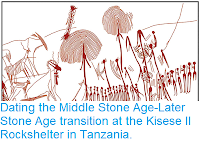The Middle Stone Age of Southern Africa dates from between 300 000 and 30 000 years ago and is made up of a succession of technologies representing the progress of Early Modern Humans in the region. The Still Bay culture is known from sites across South Africa and Lesotho, dating from about 80 000 to about 70 000 years ago, and is noted for the production of small, finely worked foliate or lanceolate points. This technology is not uniform, with considerable variation in both the techniques used to make these points and the materials used, thought to represent variations in both the available materials and culture of the tool makers across the area and time where these tools were produced. The Apollo 11 Rockshelter in the western foothills of Namibia’s Huns Mountains was first excavated in the 1970s, producing a succession of different tool assemblages from different layers, including one now recognised as belonging to the Still Bay technology, though this was not initially recognised, due to the remoteness of the site from other Still Bay assemblages, and a lack of reliable dating methods for such material until the late 1990s.
In a paper published in the journal Azania: Archaeological Research in Africa on 12 September 2018, Marlize Lombard of the Centre for Anthropological Research and Department of Anthropology and Development Studies at the University of Johannesburg, and the Stellenbosch Institute for Advanced Study at Stellenbosch University, and Anders Högberg of the Centre for Anthropological Research and Department of Anthropology and Development Studies at the University of Johannesburg, the School of Cultural Studies Archaeology at Linnaeus University, and the Stellenbosch Institute for Advanced Study at Stellenbosch University, present a comparative analysis of the Apollo 11 Rockshelter material to other Still Bay tool assemblages, with particular emphasis on the Umhlatuzana site in KwaZulu Natal and the Hollow Rock Shelter in the Western Cape.
Map of Southern Africa showing the location of Apollo 11, Hollow Rock Shelter and Umhlatuzana. Current rainfall zones are marked with light grey and white lines. East and north of the white line is the summer rainfall zone. West of the light grey line is the winter rainfall zone. Between the lines is the year-round rainfall zone. The background map is a composite satellite image of Southern Africa in November 2002. Lombard & Högberg (2018).
The Apollo 11 Rockshelter is located in an area of Dwarf Shrub Savanna, facing northwest roughly 20 m above the valley floor on the eastern slope of the ephemeral Nuob River. The shelter is about 28 m wide and 11 m deep and cut into a limestone scarp of the Nama Sedimentary Group. The Still Bay material there comes from a layer dated to about 71 000 years ago, this is overlain by a layer dated to 67 000 years ago, which has produced no archaeological material, which is in turn overlain by a later dated to 63 000 years ago which has produced material assigned to the Howiesons Poort technology.
Rock Shelter (in the middle, bottom third of the image) in the foothills of the Huns Mountains, Namibia. Ralf Vogelsang in Lombard & Högberg (2018).
The majority of the Still Bay material at the Apollo 11 Rockshelter is made from a fine-grained quartzite (sandstone), which can be obtained from the riverbed bellow the scarp or nearby outcrops. Other material is made from quartz and a calcareous mudstone, also of local origin, and Ostrich eggshell. The majority of the points are whole or almost whole, allowing investigation of the methods used to make them, though the majority have lost their bases (suggesting they were abandoned because they were no longer usable). Most of the tips were triangular in cross-section, with lenticular cross-sections also being common, but diamond, bi-convex or rhombic cross-sections, common in Still Bay tips elsewhere, are not seen.
The points, preforms and point fragments from Apollo 11 Rock Shelter included in the present analysis. The pieces are arranged according to completeness or fragmentation. Lombard & Högberg (2018).
Lombard and Högberg’s analysis suggests that while there were several different approaches to point-making used by the Still Bay people, they can be divided into two main techniques, one in which a rock blank is worked from both sides to produce a two-edged point, and one in which a already bladed rock fragment is then worked from a single side to produce the point. This second technique, common in both the Umhlatuzana and Hollow Rock Shelter Still Bay assemblages, is missing from the Apollo 11 Rockshelter material, suggesting that the tool-makers were unfamiliar with this technique. Since, at 71 000 years old, the Apollo 11 Rockshelter is quite late within the timespan of the Still Bay technology, rather than representing an early stage in the technology’s development, Lombard and Högberg suggest that this may be due to a founder effect, with a relatively small number of individuals initiating the Apollo 11 Rockshelter population, and therefore not brining all of the techniques associated with the technology with them.
Close-up of negative flake removals from pressure flaking on a point from the Apollo 11 Rockshelter. Lombard & Högberg (2018).
See also...
Follow Sciency Thoughts on Facebook.










